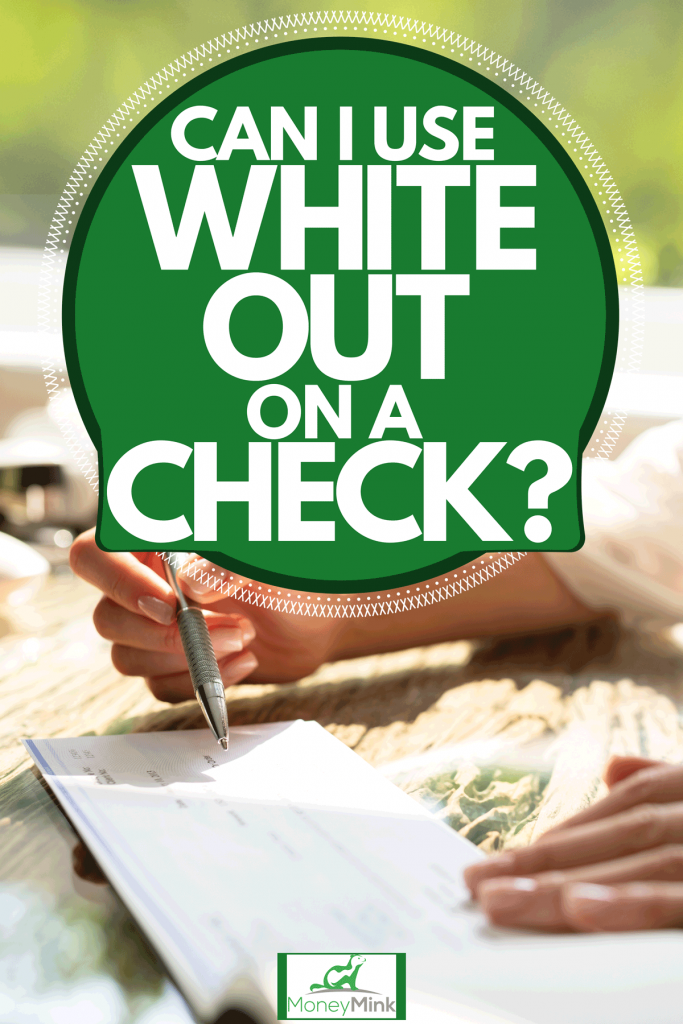You're writing a check, but you lose focus and make a mistake. To err is human, but can you correct this error with white out? Checks and finances are a serious business, so we've researched this topic and have come up with the answer.
You shouldn't use white-out on a check because banks may view this as potentially fraudulent. There are ways to correct some mistakes on a check, but the bank wants to see what the mistake was before it was corrected. To be safe, however, plan on voiding the check and writing a new one.
We know that your money is essential to you, so we've put together this guide to help you navigate the world of checks. Please keep reading for more info on why you shouldn't use white-out, how to correct checks and other helpful information.

Can I use white-out on a check?
Do not use white-out on a check. Fraudulent checks are a serious issue for banks, so they're on the lookout for suspicious behavior. Completely hiding a mistake is considered suspicious behavior and could have consequences beyond the check being voided.
There are ways to correct a mistaken check in some cases. However, white-out should never be used. Banks want to see what is being corrected and make an educated decision as to whether or not to accept the correction. White-out eliminates their ability to do that.
For instance, many of us have made the mistake of writing the wrong year in January. This is not a major error and can be corrected, but if you white-out the incorrect date, it can appear to a bank that you're trying to hide something. Instead, follow the steps below to give the check the best chance of being accepted.
Can You Cross Out A Mistake On A Check?
So what should you do if you make a mistake on a check? In some cases, you can cross out an error and rewrite it. Things like signing your maiden name, putting the wrong date, or misspelling the recipient's name might be correctable. However, the amount of the check or significant changes to the recipient's name most likely won't be accepted.
Keep in mind, though, that the bank might reject the check no matter what type of error you've made. Your safest bet is to void the check and rewrite it. While the wasted check and extra-time might be a hassle, it's worth it in the long run.
If you decide to correct the check, make one single line through the error. Don't use white-out, scribble all over the mistake, or try to hide the error. Banks want to be able to see what the mistake was before you correct it. Otherwise, it will appear as if you're trying to hide something.
Then, write the correction directly above the mistake. You might have to write small, but otherwise, the bank will find it suspicious. Finally, add your initials as close to the correction you can get it. As far as writing your middle initial, do whatever you would typically do when signing your name: if you usually include a middle initial or name, do so when you correct a check.
But it's always safest to void the check and write a new one. Banks and financial institutions get to decide whether or not they accept a check. They care about this because if they accept a fraudulent or incorrect check, they may be held responsible for the error.
How do you void a check?
Voiding a check means making it unusable. Essentially, you're making it clear that this check shouldn't be deposited or cashed. The best way to do that is to use a blue or black pen or marker and write the word VOID in all capital letters across the face of the check. You can also write the word on the back of the check, on the signature line, or any other place you feel is necessary.
You can then record the voided check in your register for proof. If necessary, feel free to make a copy of the voided check before getting rid of it. Then you can write a new check.
The color of the writing utensil you use on a check doesn't only matter when voiding it. Check out this article for more info on what color to use when writing a check: What Color Pen Should You Use When Writing Checks?
What should you do if someone made a mistake on a check they gave me?
In the frustrating situation that someone made a mistake on a check that they gave to you, do not try to correct anything. The check will be immediately deemed fraudulent and could have other consequences. The best way to handle this situation is to ask the check writer to write a new check. Carefully look over the check when it's given to you so that you can solve any disputes at that time.
What Should You Do If A Check Is Made Out To The Wrong Name?
The UCC -- Universal Commercial Code -- says that a check should be paid to the intended recipient, even if there is a misspelling or mistake in the name. This can happen if your grandmother puts your nickname on the recipient line (Joey instead of Joseph), you get married, and you change your last name, but the check writer doesn't know it or through plain old human error. Rest assured, if you're the intended recipient of the money and can legitimately prove that, you'll be able to claim it.
If you're cashing the check, sign the endorsement area with your correct name and the mistaken name. This establishes that you're responsible for both names. If you're cashing the check at the bank, you might be asked to show identification.
If you're mobile-depositing your check or using an ATM, endorse the check as described above. These banking methods have processes to correctly identify the recipient and shouldn't give you any problem. Otherwise, plan on explaining the situation to the teller with whom you're depositing the check and be prepared to show identification.
Curious about why you have to endorse a check? This article will help: What Does Endorsing a Check Mean?
Does The Date On A Check Matter?
The date on a check has some importance, but it's flexible depending on the financial institution and the sender. To be safe, make sure to write the date on the check correctly. Also, cash or deposit checks as soon as possible after receiving one.
Banks don't have to accept checks six months past their written date. This is to protect the sender from an unexpected decrease in their bank account. It also cuts down on fraud so that a check that's found by an unintended recipient months later can't be deposited. Some banks, however, will accept the check no matter how far past the date.
Postdating a check is a popular practice, but it's based on misconceptions. Some people might date a check for later to ensure that they have time to get enough money in the account. However, banks are under no obligation to wait until the date of the check arrives.
Stale checks are another ambiguous dating issue. Some checks -- particularly those sent by businesses -- have a disclaimer that the check should be voided after ninety days. Again, some banks won't respect that unless the check writer has specifically instructed them to.
In Closing
If you make a mistake while writing a check, don't use white-out to correct it. There are ways to fix some errors on a written check, but banks want to see the error and the correction. To be safe, though, you should void the check and write a new one. Follow these instructions so that you can make sure your money goes where it's intended.



